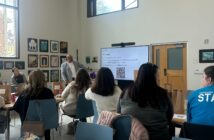It’s a tale as old as advertisement.
With only a few weeks left until the 2022 midterm elections, candidates and interest groups are spending billions of dollars to flood the airwaves with ads labeling their opponents as “extremists.”
In Pennsylvania, voters can’t click on a Youtube video or scroll through their social media feeds without seeing snappy commercials claiming John Fetterman is “just too liberal on crime,” and Dr. Oz is “so extreme he’d ban abortion.”
Candidates spend every second they can convincing voters they are the only thing standing between our nation and the far-left/right radicals trying to overthrow the country.
But is any of it true?
“Of course!” a loud contingent of partisans yell directly at one another. And in some ways, they aren’t wrong.
American citizens are starkly divided on many cultural issues, and the amount of vitriol political opponents spew at one another has only increased in recent years.
It seems naive to question the notion that Americans face extreme amounts of ideological division. There is a plethora of pundits from both parties who base their careers on culture war issues like abortion, voting rights and gun control.
It’s all we talk about, and that’s precisely the point.
With all our political energy spent duking it out over incremental changes to the status quo, most Americans never take the time to think about the elements of government we aren’t fighting over.
This is not to say that these culture war issues are inconsequential. Debates over the right to own a gun or to have a safe and legal abortion are unquestionably important and can have a permanent impact on people’s lives. Still, these topics are just a small part of a much larger system.
Our political culture is far more hegemonic than the news may lead us to believe.
When looking at the ideological values of the United States on the political compass, both major political parties in the United States occupy a small section of the full range of views.
The Republican Party falls well into the right wing of the compass, and the Democratic Party’s many factions align themselves anywhere from decently right-wing to barely right-of-center.
For all the talk of “radical leftists” on the culture war front, a left-wing economic party in the United States does not really exist.
Millions of Americans may believe their midterm vote will help decide whether or not the United States becomes a far-left socialist state or a far-right fascist dictatorship. But they will really be deciding on which flavor of the same old plutocratic liberal-democracy reflects their cultural stance.
Well actually, it’s a bit more complicated than that.
If I were writing this column six years ago, it would end here with some cliche note about how, for all their campaign trickery, Fetterman and Oz are one and the same.
However, given all that has happened since 2016, that oft-repeated sentiment about the illusion of choice in American politics simply doesn’t ring true like it used to.
Both sides of the political aisle have started embracing more ideological extremes.
Starting on the “left,” recent polling data has shown that socialism is just as popular as capitalism among young people. Evidence of this growing shift can be seen in the electoral success and popular appeal of democratic-socialists such as Bernie Sanders and Alexandria Ocasio-Cortez.
My bias compels me not to make any value judgments here on this resurging leftist ideology, but there is ample editorial material available both in support and opposition to this view for anyone interested in learning more.
Looking at the Republican party, things get a bit more complicated.
Democrats have called Trump a fascist since he first ran for president, devaluing the word and causing those on the right to close their ears before pundits can utter another syllable.
I sympathize with their frustration in an age of hyperbole, but I’m not so sure if the media is overstating anymore.
While I hesitate to throw around the F-word without providing solid theoretical evidence, there have been scores of scholarly articles published in recent years, from master’s students in sociology to distinguished professors of philosophy, showcasing how fascist tendencies may present themselves within the American right.
Once again, I will refrain from editorializing any more of my personal views, as I expect that my 20-year-old hubris prevents me from having an objective viewpoint on these complex political issues.
In any event, the question remains: do Americans have any ideological choice in this upcoming election?
It’s hard to say.
Those with strong partisan attachments will likely continue to see the other party as full of extremists. My only hope is the American public chooses to educate themselves on where they stand and what they stand for, regardless of where that inquiry may lead them.






Comment policy
Comments posted to The Brown and White website are reviewed by a moderator before being approved. Incendiary speech or harassing language, including comments targeted at individuals, may be deemed unacceptable and not published. Spam and other soliciting will also be declined.
The Brown and White also reserves the right to not publish entirely anonymous comments.
6 Comments
You fail to note that fascism exists in the far left democratic socialist side as much or more than on the far right.
Fascism certainly applied to Lenin & Stalin &applies in China where the state controls the people. Biden has moved into that world more than Trump with his latest fascist move being forgiving student debt without legislative approval.
Forcing the less well do do to pay for middle & upper class kids to go to
College is bizarre abuse of presidential authority.
What you say is true. Congress has abdicated its authority and has allowed presidents to gladly usurp it. The Job One of Congress is to get re-elected.
Trump has gladly used Fascists for his own purposes. He is a dictator wannabe who is somewhat apolitical except when it can be used for personal advantage.
“My only hope is the American public chooses to educate themselves on where they stand and what they stand for, regardless of where that inquiry may lead them.” This is not happening in government nor in the public at large. Our country was set up to discuss and compromise words despised almost as much as your “F” word.
“The Republican Party falls well into the right wing of the compass, and the Democratic Party’s many factions align themselves anywhere from decently right-wing to barely right-of-center.” This statement seems to put the writer far left of true center.
As a young Lehigh grad I voted Democratic and as a retired Lehigh alumnus I typically vote Republican. This I assume is a somewhat natural progression although progressive Democrats as youth, probably stay that way. Note that President Biden as a young Democratic Senator would probably be considered a Republican in todays politics. He has moved left. Sen Ben Sasse has described the left as those who believe people are victims or perpetrators and the right who see people as law abiding or anarchists.
True Republicans are either leaving the swamp or learning to like alligators and liars. The right wing are the true Rinos who follow a leader who is an egotist whose politics are not left nor right but fluid.
For the good of the country people need to talk and compromise for the good of the country and not for the good of me or my affiliation group.
“In any event, the question remains: do Americans have any ideological choice in this upcoming election?” This is not the question I have; mine is: Do we have any candidates with enough character and intelligence to do what is best for our country.
Brendan, thank you for giving us the truth as you see it. I wish most of our politicians did the same.